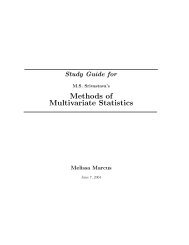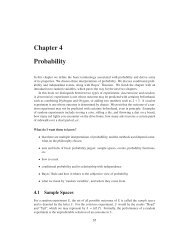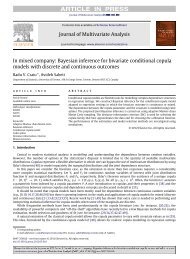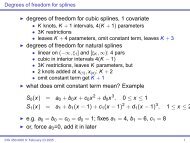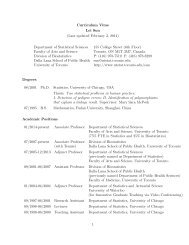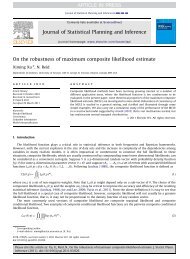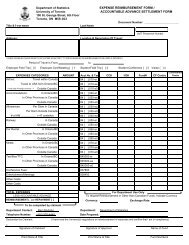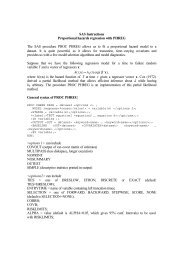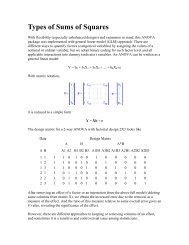Chapter 5 Discrete Distributions
Chapter 5 Discrete Distributions
Chapter 5 Discrete Distributions
Create successful ePaper yourself
Turn your PDF publications into a flip-book with our unique Google optimized e-Paper software.
5.7. FUNCTIONS OF DISCRETE RANDOM VARIABLES 131<br />
Proposition 5.30. Let X be a discrete random variable with PMF f X supported on the set S X .<br />
Let Y = h(X) for some function h. Then Y has PMF f Y defined by<br />
∑<br />
f Y (y) = f X (x) (5.7.2)<br />
{x∈S X | h(x)=y}<br />
Example 5.31. Let X ∼ binom(size = 4, prob = 1/2), and let Y = (X − 1) 2 .Considerthe<br />
following table:<br />
x 0 1 2 3 4<br />
f X (x) 1/16 1/4 6/16 1/4 1/16<br />
y = (x − 2) 2 1 0 1 4 9<br />
From this we see that Y has support S Y = {0, 1, 4, 9}. Wealsoseethath(x) = (x − 1) 2 is<br />
not one-to-one on the support of X, becausebothx = 0andx = 2aremappedbyh to y = 1.<br />
Nevertheless, we see that Y = 0onlywhenX = 1, which has probability 1/4; therefore, f Y (0)<br />
should equal 1/4. A similar approach works for y = 4andy = 9. And Y = 1exactlywhen<br />
X = 0orX = 2, which has total probability 7/16. In summary, the PMF of Y may be written:<br />
y 0 1 4 9<br />
f X (x) 1/4 7/16 1/4 1/16<br />
Note that there is not a special name for the distribution of Y, itisjustanexampleofwhat<br />
to do when the transformation of a random variable is not one-to-one. The method is the same<br />
for more complicated problems.<br />
Proposition 5.32. If X is a random variable with IE X = µ and Var(X) = σ 2 ,thenthemean<br />
and variance of Y = mX + bis<br />
µ Y = mµ + b, σ 2 Y = m2 σ 2 , σ Y = |m|σ. (5.7.3)



